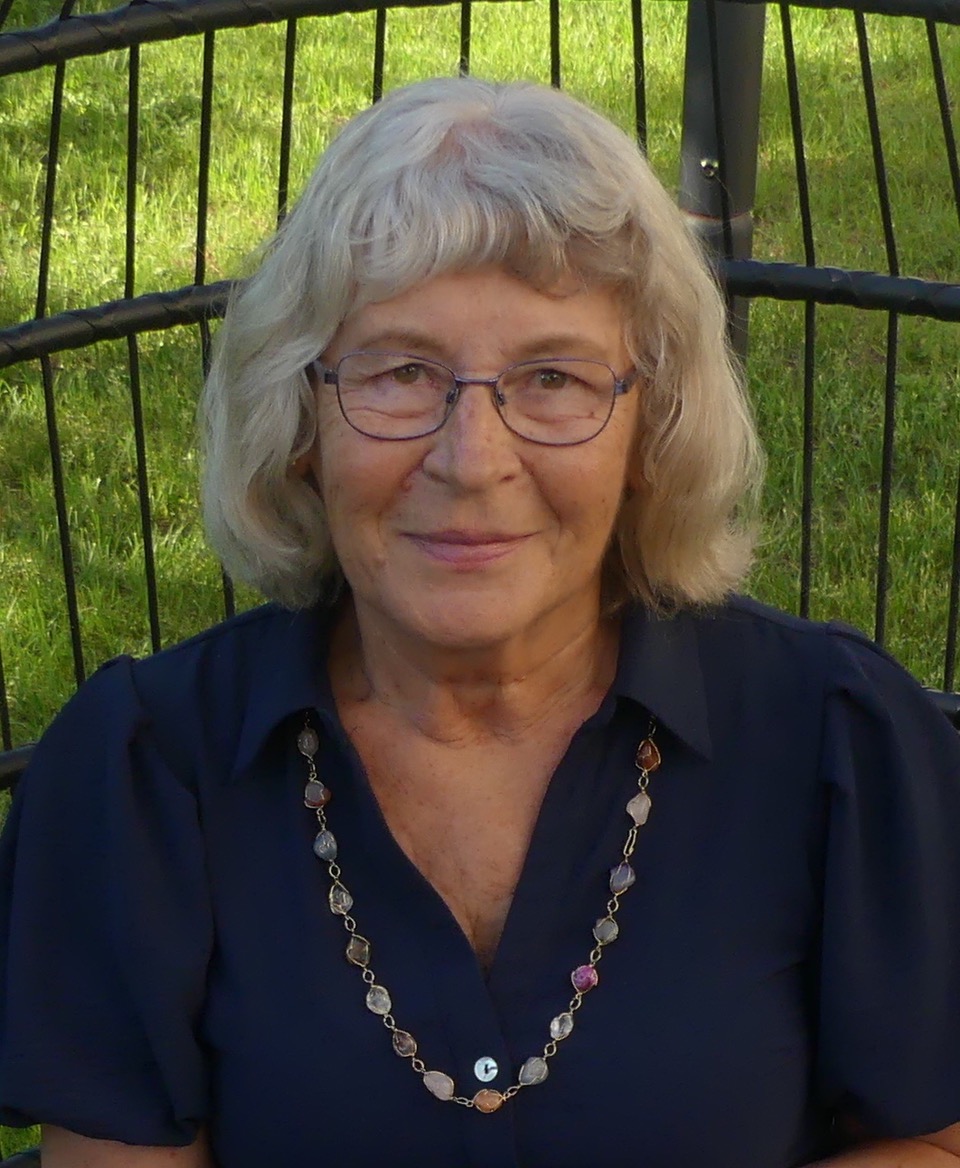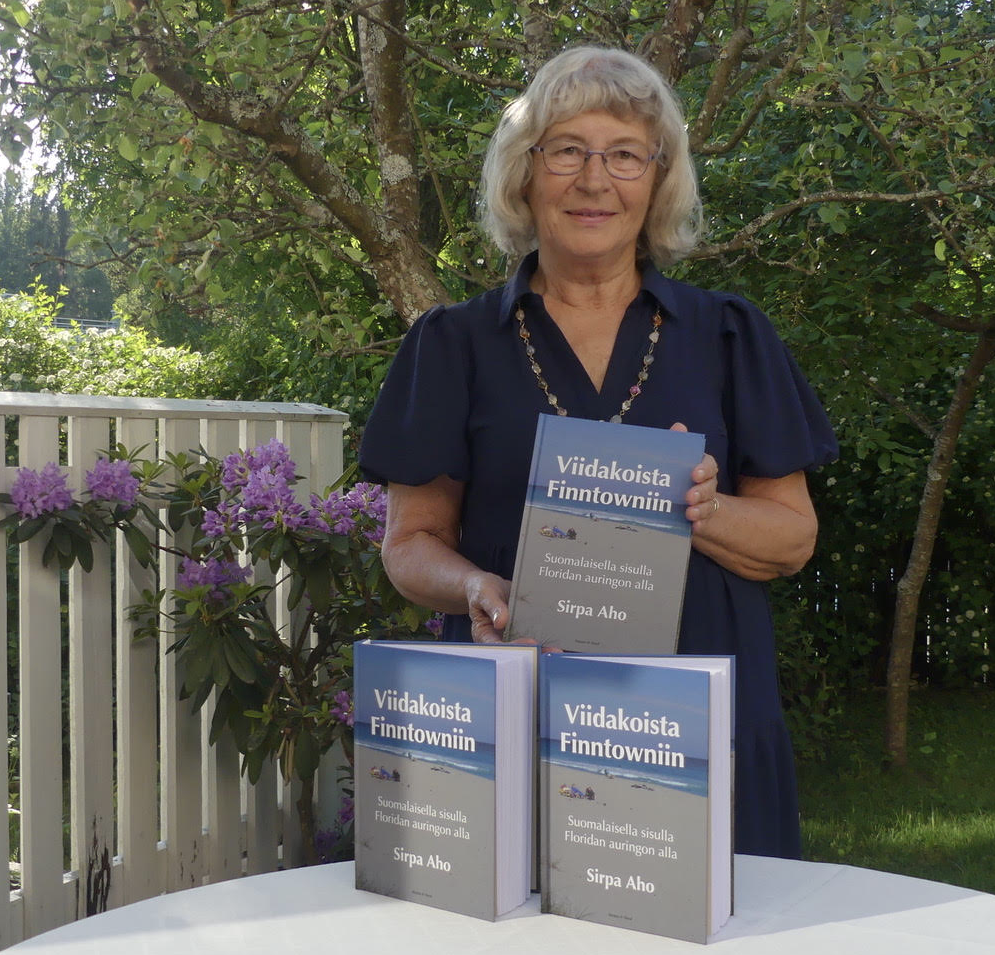
The Story of Sirpa Aho's Sisu
Written by Nina Dahlblom, The Finnish American Reporter
Sirpa Aho, former Harvard researcher uncovers the remarkable role of Florida Finns in the state history. Read the story of a rare community activist who is celebrating researcher William Copeland's legacy in her new debut book "From the Jungle to Finntown – Finnish Sisu Under Florida’s Sun".
Sirpa Aho is busier than ever as she dives headfirst into promoting her new book at Finland’s oldest book fair in Turku this September. In the background, towering stacks of blue-covered copies of her debut work, From the Jungle to Finntown – Finnish Sisu Under Florida’s Sun, await eager readers. Though one foot is already out the door, our shared fascination with the stories of Finnish Americans extends our one-hour meeting into ninety minutes.
As an international scientist, biochemist, mother, community activist, world traveler and now also author, Sirpa Aho listens closely to my thoughts about the modern Finnish community in America. We establish an instant connection, recognizing similarities in our thinking, values, experiences, and interests. Sirpa’s friendly demeanor radiates Finnish practicality. Finding a shared wavelength comes effortlessly.
A Finnish Researcher’s Journey to the U.S.
Sirpa's roots lie in Meri-Masku, a small town in the scenic Turku archipelago in Finland. Yet, Sirpa insists she’s not at all a history enthusiast—her focus is always on the future. “And I’m not an author either—that was never in the plans. And Meri-Masku was quite small, and winters were long and dark. We lived mostly within the family. As a child, schoolwork was what kept me engaged,” she says.
Luckily, Sirpa found her passion in biochemistry, specifically in cell and molecular biology. She admits that her then introverted nature was useful for cell culture work, although not so much in other areas. “My dissertation was on lung silicosis,” Sirpa says. As she explains, silicosis is a lung disease caused by the growth of harmful fibrous tissue in the lungs, eventually leading to respiratory failure.
Sirpa’s connection to the U.S. began when she worked as a postdoc at Harvard in Boston for three years. During her time there, she held a junior researcher position funded by the Academy of Finland, conducting high-quality, innovative research aimed at scientific breakthroughs. “It was an excellent vantage point for building networks.”
Upon returning to Finland, Sirpa worked at the University of Turku for over a decade. "And at Alko's research laboratory, collaborating with VTT and the University of Helsinki. Back then, genetic engineering and cloning were still unfamiliar. We studied yeasts and molds, focusing on tissue biology, enhancing strains, and breaking down cellulose with early biotechnology."
The Move to the U.S. and Shifting Career Paths
In the early 1990s, Finland faced an economic recession that changed everything. The European Union came, and Alko restructured. Sirpa’s husband’s shipyard was sold. "If the work situation in Finland hadn’t changed so drastically, we probably wouldn’t have moved to the U.S.," Sirpa reflects on those turbulent times. "And if I hadn’t worked at Harvard before, we might have made a different choice."
Sirpa initially landed in Philadelphia, working at a university for ten years with her own research group focused on skin cell studies. She handled the transition between countries and fields with ease. "Every field teaches you something new. Work is work. Research projects keep you engaged 24/7."
However, after some time, Sirpa began craving new challenges. “I thought, that’s enough, and I started applying for industrial jobs. That’s when I joined Unilever’s skin lab,” she says. At Unilever, Sirpa helped develop synthetic skin for product testing. "We tested compounds that promoted skin regeneration—developing skincare products, basically," Sirpa explains. Although corporate life differed from academia, she adapted well. "The funder decided what we did, but I was able to use my expertise effectively."
Community Leadership and the Finnish Legacy in Florida
While excelling in her biochemical career, Sirpa and her husband also became deeply involved in the Finnish community in Philadelphia. Her husband served as president of the Finnish American Society of Delaware during the early 2000s, while Sirpa focused on writing grant applications for her research. In 2001, they began attending Finnish festivals in Florida, where they eventually bought a holiday home.
“I never thought I’d retire; I saw myself as a lifelong researcher. But then we bought a vacation home in Palm Beach, and retirement started to seem like a good idea,” she laughs. Eventually, the couple moved to Florida permanently, buying and renovating a house in 2011.
Sirpa and her husband soon found themselves deeply involved in Florida’s Finnish community, with Sirpa becoming chair of the Finnish House in Lantana just a month after moving. Her commitment to preserving the Finnish legacy in Florida led her to spearhead numerous projects and events over the next decade.
Florida: A Paradise for Finnish Vacationers and Retirees
Florida’s history is rich with Finnish pioneers. Florida became a well-known haven for vacationers and retirees in Finland after a tourist boom from the 1970s through the 1990s. Many have heard of "Finntown," a vibrant Finnish community where Finnish speakers thrive. The area boasts Finnish saunas, bakeries, car rental agencies, and a unique sense of heritage, sustained by Finnish immigrants who, in many ways, seem even more patriotic than those back home. They dance traditional Finnish folk dances and tango, bake sweet bread and Karelian pasties, and reminisce about the "old days."
“The challenges people overcame are inspiring,” says Sirpa Aho, and continues “Take Matti Portti, who arrived in 1919 to an untouched wilderness. He cleared fields among alligators and snakes. After five years in Chicago, where he’d already started a family with four children, the Great Depression hit in 1929. That’s when he decided to return to Florida, hoping to farm and keep his family fed.” In Florida, Matti cultivated cabbages, feeding some to his pigs for meat to sustain his family and sell. He even made tar to earn extra money."
Fast forward about a hundred years from Matti's time: in early 2017, Finnish historian and professor William Copeland, a researcher specializing in China and Russia, attended an event organized by Sirpa Aho and her dedicated team at the Suomitalo (“Finnish House”) community center. Although Copeland lived in Finland, he had spent winters in Florida since 1949. Initially, he attended events at another Finnish community center, but during Sirpa's tenure as chair, he began coming to Suomitalo to share insights from his research on Finnish-Americans in Florida.
For years, first time in 1960s, there was interest in documenting the history of Finns in Florida, yet no one had stepped up to tackle the project. When two members of the historical society passed away and a third became ill, the project stalled entirely. Eventually, Copeland’s medical condition prevented him from traveling back to the U.S. However, he’d already left a significant collection of research materials at Suomitalo for safekeeping.
Sirpa Takes Up Copeland's legacy
Intrigued, Sirpa took it upon herself to organize Copeland’s work. “I decided to dig into it, sorting Copeland's materials into separate piles for personal cards, valuable interview content, and so on,” she recalls. The stories captured her imagination. Thanks to Sirpa's dedication, over 50 pages of interview transcripts are now edited and preserved.
Sirpa deeply respects Copeland’s work. “Each story, complete with dates and places, was like a new window into a world I hadn’t known,” she says. “Copeland had already compiled summaries and articles, but he never got to write a book. His primary career as a professor and expert on Russia and China demanded much of his time, and this research was simply his passion project.”
With Copeland’s blessing, Sirpa had full freedom to use the materials as she wished. Family-related documents were returned to Copeland’s sons, and academic materials went back to his university. However, she kept photographs and documents relevant to Florida, carefully documenting and photographing each piece. She even took portions of the collection to Finland’s Institute of Migration.
By the end, Sirpa had two suitcases of documents and a third filled with old cassette tapes. When asked how she managed to listen to them, she explains, “I bought two cassette players from a secondhand shop, so I could go through all the tapes.” Sirpa found many stories already transcribed or photocopied, and as she pieced together fragments, a cohesive narrative of Finnish life in Florida began to emerge.
A Sequel in the Works
Sirpa is already planning a sequel, covering Finnish history in Florida from World War II to the present. "While many books have been written about Finnish immigrants in America, the role of Finns as pioneers in Florida remains untold."
But first, Sirpa will take a well-earned break. After wrapping up her book tour, she plans to spend Christmas in Atlanta with her son’s family before embarking on a South American cruise that will take her as far as Antarctica.
“Forty-two ports, samba in Rio, and Antarctica—I can’t wait,” Sirpa says with a smile.

From the Jungle to Finntown – Finnish Sisu Under Florida’s Sun by Sirpa aho is available in Finnish bookstores.
This article was published in The Finnish American Reporter in November 2024
About the writer of the article:
Nina Dahlblom is a free feature article writer from San Jose, California telling the unique stories of very special ordinary people.
0 Comments Add a Comment?